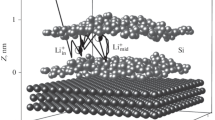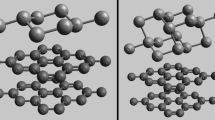Abstract
Mechanical properties and stability of two layers of defect silicene supported by graphene sheets, between which the lithium ion passes under an electrostatic field, are studied by the molecular dynamics method. Defects are mono-, di-, tri-, and hexavacansies. Graphene and silicene edges are rigidly fixed. Graphene sheets contacting with silicene take a convex shape, deflecting outward. Mono- and divacancies in silicene tend to a size decrease; larger vacancies exhibit better stability. The ion motion control using an electric field becomes possible only using perfect silicene or silicene with mono- and divacancies. The ion penetrated through larger defects, and its motion in the silicene channel becomes uncontrolled. When the ion moves in the channel, the most strong stress spikes appear in silicene containing monovacancies. In the case of fixed edges, perfect silicene intercalated with a lithium ion is inclined to accumulate larger stresses than silicene containing defects.
Similar content being viewed by others
References
A. Kara, C. Leandri, M. Davila, P. Padova, B. Ealet, H. Oughaddou, B. Aufray, and G. LeLay, J. Supercond. Nov. Magn. 22, 259 (2009).
M. Topsakal and S. Ciraci, Phys. Rev. B: Condens. Matter 81, 024107 (2010).
Y.-L. Song, Y. Zhang, and J.-M. Zhang. Appl. Surf. Sci. 256, 6313 (2010).
B. Aufray, A. Kara, S. Vizzini, H. Oughaddou, C. Leandri, B. Ealet, and G. Le Lay, Appl. Phys. Lett. 96, 183102 (2010).
M. Neek-Amal, A. Sadeghi, G. R. Berdiyorov, and F. M. Peeters, Appl. Phys. Lett. 103, 261904 (2013).
R. E. Peierls, Ann. Inst. Henri Poincare 5, 177 (1935).
L. D. Landau, Phys. Z. Sowjetunion 11, 26 (1937).
K. Kawahara, T. Shirasawa, R. Arafune, C.-L. Lin, T. Takahashi, M. Kawai, and N. Takagi, Surf. Sci. 623, 25 (2014).
G. A. Nritsaris, E. Kaxiras, S. Meng, and E. Wang, Nano Lett. 13, 2258 (2013).
J. Tersoff, Phys. Rev. B: Condens. Matter 38, 9902 (1988).
J. Tersoff, Phys. Rev. B: Condens. Matter 39, 5566 (1989).
A. Yasukawa, Jpn. Soc. Mech. Eng. 39, 313 (1996).
F. Benkabou, M. Certier, and H. Aourag, Mol. Simul. 29, 201 (2003).
R. Yu, P. Zhai, G. Li, and L. Liu, J. Electron. Mater. 41, 1465 (2012).
S. K. Das, D. Roy, and S. Sengupta, J. Phys. F: Met. Phys. 7, 5 (1977).
T.-E. Fang and J.-H. Wu, Comput. Mater. Sci. 43, 785 (2008).
N. Ding, J. Xu, Y. X. Yao, G. Wegner, X. Fang, C. H. Cheng, and I. Lieberwirth, Solid State Ionics 180, 222 (2010).
S. Plimpton, J. Comput. Phys. 117, 1 (1995).
A. E. Galashev and Yu. P. Zaikov, Russ. J. Phys. Chem. A 89 (12), 2243 (2015).
A. E. Galashev and Yu. P. Zaikov, Russ. J. Electrochem. 51 (9), 867 (2015).
D. W. Brenner, Phys. Rev. B: Condens. Matter 42, 9458 (1990).
S. J. Stuart, A. B. Tutein, and J. A. Harrison, J. Chem. Phys. 112, 6472 (2000).
A. E. Galashev and O. R. Rakhmanova, Phys.—Usp. 57 (10), 970 (2014).
A. E. Galashev, Tech. Phys. 59 (4), 467 (2014).
P. Erhart and K. Albe, Phys. Rev. B: Condens. Matter 71, 035211 (2005).
B. Peng, F. Cheng, Z. Tao, and J. Chen, J. Chem. Phys. 133, 034701 (2010).
J. K. Lee, K. B. Smith, C. M. Hayner, and H. H. Kung, Chem. Commun. (Cambridge) 46, 2025 (2010).
Author information
Authors and Affiliations
Corresponding author
Additional information
Original Russian Text © A.E. Galashev, O.R. Rakhmanova, Yu.P. Zaikov, 2016, published in Fizika Tverdogo Tela, 2016, Vol. 58, No. 9, pp. 1786–1793.
Rights and permissions
About this article
Cite this article
Galashev, A.E., Rakhmanova, O.R. & Zaikov, Y.P. Defect silicene and graphene as applied to the anode of lithium-ion batteries: Numerical experiment. Phys. Solid State 58, 1850–1857 (2016). https://doi.org/10.1134/S1063783416090146
Received:
Published:
Issue Date:
DOI: https://doi.org/10.1134/S1063783416090146




